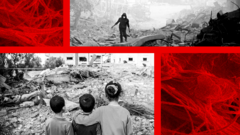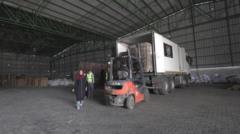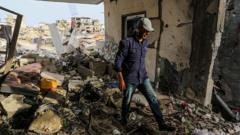The destruction left in the wake of military actions poses severe long-term health risks due to asbestos contamination in the rubble.
**Asbestos Crisis Emerges Amidst Gaza's Ruins**

**Asbestos Crisis Emerges Amidst Gaza's Ruins**
A hidden health disaster looms in Gaza following its recent military conflicts.
The aftermath of Israel's military operations in Gaza has unleashed a chilling threat: asbestos contamination. This once-popular building material, now banned in many countries due to its health hazards, becomes a silent perpetrator of deadly illnesses when fibers are released into the air. The United Nations Environment Programme (UNEP) reports that Gaza's older structures, particularly in eight urban refugee camps created post-1948-49 conflict, still contain significant amounts of asbestos, primarily in roofing.
Current estimates suggest that up to 2.3 million tons of debris within Gaza could be tainted with this hazardous material, a scenario reflecting a dire public health crisis as articulated by Professor Bill Cookson, director of the National Centre for Mesothelioma Research in London. "The rubble is extremely toxic, and its impact will linger," cautioned Cookson, echoing concerns raised by Liz Darlison, CEO of Mesothelioma UK. The long-term consequences of this exposure may include serious ailments like mesothelioma, a malignant form of cancer linked to asbestos that typically manifests between 20 to 60 years post-exposure, suggesting future health ramifications for current inhabitants.
In densely populated Gaza, with a population of roughly 2.1 million within an area smaller than a quarter of London, the risk of inhaling asbestos fibers is high. Dr. Ryan Hoy, an expert on dust inhalation, warns that the fine particulate nature of these fibers makes them readily airborne and extremely difficult to avoid. Yet, the immediate threat of violence from military operations overshadows this looming health hazard, as residents prioritize survival over asbestos awareness. "The reality is that people are focused on whether they will be hit by bombs rather than the risks posed by dust inhalation," remarked Chiara Lodi, a medical coordinator for Medical Aid for Palestinians.
Historically, studies conducted after previous conflicts revealed asbestos present in buildings and infrastructure. While global efforts have progressed to ban its use entirely in 68 countries, the legacy of previous construction practices leaves communities vulnerable. The risks extend beyond mesothelioma to encompass other critical health threats, including various cancers and respiratory diseases often exacerbated by dust exposure.
The impending reconstruction of Gaza raises urgent questions regarding the safe handling of asbestos-laden debris. A UN assessment notes that debris removal might take up to 21 years and could cost around $1.2 billion. Darlison elaborated on the logistical challenges, stating that while the properties of asbestos made it popular in construction, they complicate its removal and safe disposal.
The military conflict that initiated this current humanitarian crisis began following a Hamas attack resulting in significant Israeli civilian casualties. The aftermath has led to a staggering death toll, exceeding 53,000 Palestinians, primarily women and children, as reported by Gaza's Hamas-led health ministry.
While reconstruction efforts are proposed by various stakeholders, including the U.S. and Arab nations, the overarching priority must be addressing the hazardous materials present in the ruins. As the UN warns, any reconstruction plan must consider the risk of disturbing asbestos-contaminated site debris to protect the populace from further health crises.
Current estimates suggest that up to 2.3 million tons of debris within Gaza could be tainted with this hazardous material, a scenario reflecting a dire public health crisis as articulated by Professor Bill Cookson, director of the National Centre for Mesothelioma Research in London. "The rubble is extremely toxic, and its impact will linger," cautioned Cookson, echoing concerns raised by Liz Darlison, CEO of Mesothelioma UK. The long-term consequences of this exposure may include serious ailments like mesothelioma, a malignant form of cancer linked to asbestos that typically manifests between 20 to 60 years post-exposure, suggesting future health ramifications for current inhabitants.
In densely populated Gaza, with a population of roughly 2.1 million within an area smaller than a quarter of London, the risk of inhaling asbestos fibers is high. Dr. Ryan Hoy, an expert on dust inhalation, warns that the fine particulate nature of these fibers makes them readily airborne and extremely difficult to avoid. Yet, the immediate threat of violence from military operations overshadows this looming health hazard, as residents prioritize survival over asbestos awareness. "The reality is that people are focused on whether they will be hit by bombs rather than the risks posed by dust inhalation," remarked Chiara Lodi, a medical coordinator for Medical Aid for Palestinians.
Historically, studies conducted after previous conflicts revealed asbestos present in buildings and infrastructure. While global efforts have progressed to ban its use entirely in 68 countries, the legacy of previous construction practices leaves communities vulnerable. The risks extend beyond mesothelioma to encompass other critical health threats, including various cancers and respiratory diseases often exacerbated by dust exposure.
The impending reconstruction of Gaza raises urgent questions regarding the safe handling of asbestos-laden debris. A UN assessment notes that debris removal might take up to 21 years and could cost around $1.2 billion. Darlison elaborated on the logistical challenges, stating that while the properties of asbestos made it popular in construction, they complicate its removal and safe disposal.
The military conflict that initiated this current humanitarian crisis began following a Hamas attack resulting in significant Israeli civilian casualties. The aftermath has led to a staggering death toll, exceeding 53,000 Palestinians, primarily women and children, as reported by Gaza's Hamas-led health ministry.
While reconstruction efforts are proposed by various stakeholders, including the U.S. and Arab nations, the overarching priority must be addressing the hazardous materials present in the ruins. As the UN warns, any reconstruction plan must consider the risk of disturbing asbestos-contaminated site debris to protect the populace from further health crises.


















